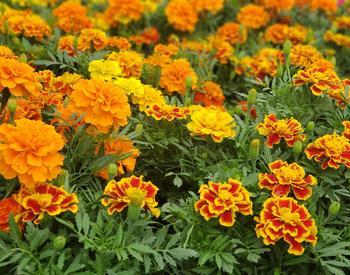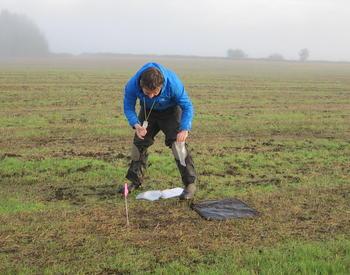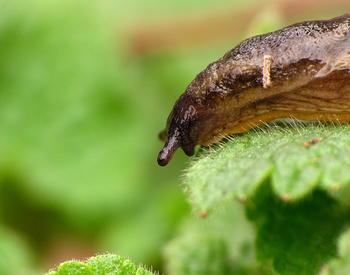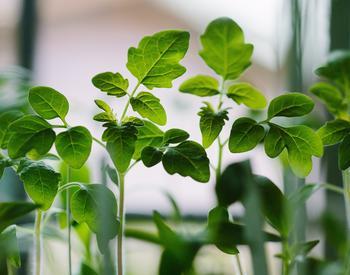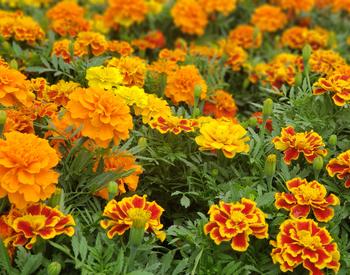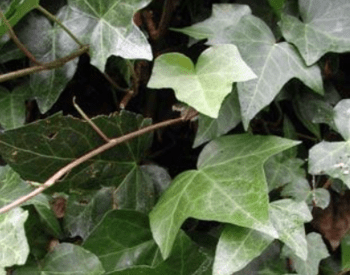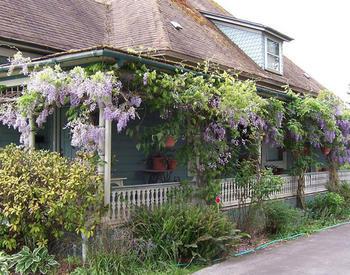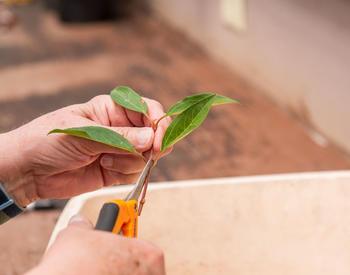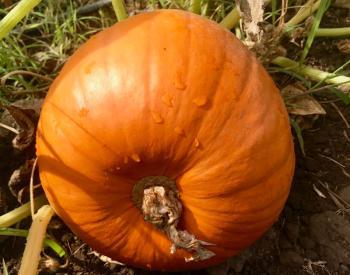Transcript
Speaker 1: From the Oregon State University Extension Service, this is Pollination, a podcast that tells the stories of researchers, land managers, and concerned citizens making bold strides to improve the health of pollinators. I'm your host, Dr. Adoni Melopoulos, assistant professor in pollinator health in the Department of Horticulture.
Welcome to 2018, guests. I am very, very thrilled today to bring you a show featuring Dr. Gail Lungalotto. Now, Dr. Lungalotto is well-loved in Oregon. She's an associate professor of horticulture here at OSU, but she is well known throughout the state because she coordinates the statewide Extension Master Gardener program. Now, she has a large research and extension appointment, and this focuses on developing a better understanding of how to design and manage gardens and parks to promote environmental and public health. Her lab group is really active as you're going to hear in this show and has projects on garden pollinators, native plants, and garden soils.
But Dr. Lungalotto is really active on a lot of fronts. She currently serves as a secretary of the National Initiative for Consumer Horticulture, where she works with industry, academic, and nonprofit leaders to document the benefits of home and community gardening and to promote public support for research and extension in consumer horticulture. I'm so pleased to kick this 2018 year off with this interview.
Not only is it really practical and you'll learn lots about gardens and pollinators, but as you're going to hear, Dr. Lungalotto has a really long horizon about thinking about pollinators in cities, so it's a great way to take stock of where we've been and where we're going with urban pollinators today on pollination. Dear listeners, today is a special day. Not only is it 2018, hooray, but I also finally have had a chance to catch up with OSU's State White Master Gardener Coordinator, Gail Lungalotto. Welcome to Pollination Gail.
Speaker 2: Thanks, Antoni. It's my pleasure to be here. I'm one of your biggest fans.
Speaker 1: Oh my God. That is a great endorsement. Thanks, Gail. We've been having conversations about bee communities and urban areas. I'm always really impressed. You have a real... It's a question you've been thinking about for a real long time. I want maybe just to set the interview up. What do you think are some of the most common misconceptions and some of the most prominent knowledge gaps when we come to think about urban landscapes and pollinators? Sure.
Speaker 2: I think the number one thing which stands out as a misconception is that many folks, even some folks who are truly passionate about pollinators, don't really understand what bees are and they don't recognize the diversity of bees that they might have in their own home garden or their own community garden. So I do go and sample bees from master gardeners' yards and a lot of these folks are really, really passionate about pollinators. But the very first time that I showed them, look, here's what we're finding in your own garden. They didn't recognize a lot of the smaller black bees, the lazyoglossum, the seratina is actually a bee. And then on top of that, they'd never even seen those insects before because they weren't looking for them. And unless you're specifically looking for them, you're not necessarily going to find them.
Speaker 1: So for a lot of people, they must know a honeybee and maybe a bumblebee, but some of these other bees are just, really, not in their search pattern. Right.
Speaker 2: They just escape their attention. They might not be as fuzzy as the bumblebee or the honeybee, and so they might mistake them as being a fly or they just might overlook them altogether. Okay.
Speaker 1: So that's the first misconception and knowledge gap is that a whole swath of biodiversity just escapes people's attention. Right.
Speaker 2: And then in terms of other misconceptions or knowledge gaps, I would really say that gardeners in particular understand that if you want to attract bees into your garden, you should plant forage for them. You should plant flowering plants, which is not too difficult to convince a gardener to do. But a lot of people really don't recognize the importance of nest sites for bees. And in particular, the importance of nest sites for ground-nesting bees. And if you think about what it is a ground nesting bee needs in order to reside in a garden, they need a place to excavate or they need a pre-made hole that they can take advantage of where they can actually build their nest.
Unfortunately, those types of microhabitats really don't suit the palette of what most home gardeners are looking for in their gardens. So bees need some type of bear space in a garden in order to make their nest, at least the ground-nesting bees do. And of course, a lot of the diversity within bees is in the ground-nesting bees, but most home gardeners don't really relish these bear spots in their garden. So there's a little bit of a push-pull there between what the bees need and what the gardeners might be looking for.
Speaker 1: I can imagine that a lawn that's a little bit patchy might be really great for bees, but you might be frowned upon by your neighbors.
Speaker 2: Right. So I always like to say that both nature and gardeners abhor a vacuum. Whenever there's blank space in a garden, gardeners tend to mulch it or they tend to plant it. But that oftentimes, or at least I think oftentimes, maybe displacing some of these ground-nesting bees is not making a great garden for ground-nesting bees.
Speaker 1: Okay. So we may not be able to recognize them, really not thinking about their full life history. There are big parts of their life history that fall out of our consideration. Are there any other things that when you look at urban landscapes and you think about how people think about pollinators, are there other gaps, really kind of urgent areas in need of some flushing out?
Speaker 2: So in terms of knowledge gaps, one of the things that I'm really interested in is if you have a single garden, just like a .2 acre lot, a standard city lot, and you have somebody who is totally gung-ho gardening for pollinators. We can wonder about the impact of that small parcel of land and what impact it makes on the total bee community across an urban landscape. And then if you think about the actions of your neighbors and what your neighbors are doing, and if you can convince like two, three, four, five other neighbors to take a similar approach to gardening so that they really are gardening with pollinators first and foremost in their mind, what is the impact of those aggregate city lots gardening for pollinators on pollinator communities? And is there a tipping point? Like what is the meaningful scale in an urban landscape for pollinator conservation? I think that that's a question that we don't have the answer to yet and that it's going to be a very difficult question to answer experimentally, quite honestly.
Speaker 1: Yeah, I guess it's not like an agricultural experiment where you can set up the plot. This came up in the interview with David Lowenstein, how you can't even see the backyards. So you kind of like are already, it's a very difficult area to do research in.
Speaker 2: It is a difficult area to do research in, but that's one of the great things about working with master gardeners. We put a call out there and said, hey, do you mind if we hang out in your backyard for three consecutive summers and folks were really eager about letting us in. They provided their plant list to us. They let us know what they're planting and we go on a monthly basis during the growing season to sample pollinators. But can I get to, I think I know how we might be able to actually get at this question of scale.
And what is the meaningful scale? So it's just an idea, but I'm thinking if we work with gardens that are in a neighborhood that's in an HOA, a homeowners association versus not in an HOA. So when you live in a community that's governed by homeowner association rules, the yards look pretty similar from yard to yard because everybody kind of, they have to abide by the same set of rules. But when you're not in an HOA, you have a greater diversity of planting styles.
So I think of the HOA that if we can look at gardens both in and outside of like the HOA bylaws, policies, and procedures, that'll give us some sense of what it means to scale up particular plantings and what it means to have fragmented plantings where not everything looks the same yard to yard. So it's just an idea. We'll see if it works.
Speaker 1: That is brilliant. It's such a great idea because then you would have a coarser scale kind of homogeneity and you could see what the impact of your one garden is in that homogenous landscape. And you can see in a heterogeneous, that's a really great design.
Speaker 2: I hope so.
Speaker 1: So I think the trick number one will be getting it funded. Trick number two will actually be finding gardeners within HOAs who would want to work with us. We move on to the next question. The one thing that I love to hear you maybe talk a little bit about is when we think of pollinator research, there's often a lot of money and resources available for agricultural research. But urban landscapes don't have a commodity group or commission. Tell us about it. It must be challenging to kind of get this work moving.
Speaker 2: Right. It is.
Speaker 1: It's very challenging to get this work moving. But I do have to say that our work has been funded by the master gardeners themselves. Both are individual master gardeners. Sherry Scheng has been very supportive of our pollinator research as well as master gardener associations. The Oregon Master Gardener Association and its chapters have also supported the work that we do. But because it has been really difficult to get pollinator research in urban areas funded, I've kind of aligned myself with this national organization, which is called the National Initiative for Consumer Horticulture, which we just call NICH and ICH. NICH is really focused on trying to bring together leaders in industry, nonprofit, and academia sectors to identify high-priority research and extension projects associated with consumer horticulture, which is really just gardening and landscaping. And pollinators seem to be something that everybody can get behind. The landscapers, the nursery producers, the retail nurseries, the academics. And so that's part of how we're trying to remedy that is to have a united voice about the importance of gardening and landscaping to address some key environmental and public health issues. Oh, of course. I'm thinking also back to the interview we had with Dr. Franks about just how a lot of these things are integrated issues, pollinator health, and sort of shading the city can they map onto one another? Definitely.
Speaker 2: Yeah, there are a lot of these overlapping overlapping elements, if you will. You know, the use of pesticides is an environmental issue, but it can also have public health consequences. The amount of street trees is both an environmental issue, but it can also have public health consequences when you're looking at heat load within an urban area when you're looking at particulate matter, and impacts on asthma for folks living in urban areas. So it's all it's all integrated. And I truly do believe that it is possible to design and maintain cities so that they promote environmental and human health. Ultimately, that is the goal of our program is to identify what are those factors. What are those plants? What are those practices that we should be using to promote environmental and human health in urban areas?
Speaker 1: That's great. Well, let's come back to how that might be done. So I remember we've had a conversation previously or I think you might even brought the paper to my attention. There's this really, Mihail Garbazoff and Francis Radniak have this paper called List Mania, Strengths and Weaknesses of Lists of Garden Plants to Help Pollinators. And I just want to, you know, think about like how we can get people, you know, the actual how to do the first thing that people talk about our plant lists. What are some of the key challenges around recommending plants for landscapers and gardens in urban areas? And tell us about some of the research that's happening in your own lab around plant selection. Sure.
Speaker 2: So the Garbuzoff and Radniak's paper, they do a really good job of pointing out, you know, hey, here are these 12 lists of plants which are out there in circulating, which are recommending plants for pollinators. And out of these 12 plants, I don't have 12 lists of plants, I don't remember the exact number off the top of my head. Very few of them are actually based on quantitative research and rigorous observations. And so they point out that a lot of the lists are put together anecdotally, that they seem to represent someone's personal preferences for particular plants. And in order to have really good information about what plants really are known to be highly attractive to pollinators, we need to have more rigorous observations and research trials. So in my lab right now, Aaron Anderson is a graduate student who's looking at native plants. He is particularly passionate about native plants.
And so he selected 23 species of the Lamont Valley native plants. And he is basically describing the insect community that's associated with each of their blooms. The ultimate outcome of that research is to try to generate a list of native plants that are attractive to pollinators. But we're also going to have gardeners come in and rate the plants for their attractiveness and see whether or not they would fit within their own garden design. Aaron also compares those 23 species of native plants to the pollinator communities that are associated with four plants, which are known to be highly attractive to pollinators.
We selected those four plants from Garbouzoff and Ratnick's lists of, you know, here's quantitative rigorous research showing that these four plants are highly attractive to pollinators just to try to see how the natives compare to these known attractive plants for pollinator communities.
Speaker 1: That's great. And we really do. I'm really hoping to catch up in the new year with Aaron because I think a lot of people around the state know about the project and are real excited about it. So this seems like the way forward in some ways to be able to set a plot up with these different plants and be able to assess them. There are also initiatives to assess plants that are in place that may just wrap this segment up, just tell us about the challenges of that kind of work. Sure.
Speaker 2: Well, I think there are challenges with both types of a project. So what Aaron's doing is he has these one-meter square plots, which are separated by, gosh, I think they're separated by six meters from any nearest plot. So anyway, it takes up a lot of land and it takes a lot of money to plant and to maintain that project. But there you can kind of get a bit more of an independent assessment of what's coming to that particular group of plants. Now, actually, there are a lot of initiatives to look at plants in place in gardens.
And the challenge there is that gardens vary so much from one to another in terms of their plant community composition. So it's really hard to tease apart what might be driving pollinator visits. Is it the particular plant that you actually are noticing the pollinators on? Or is it the surrounding plant community that's drawing those pollinators into the garden in the first place?
It might be possible to get at that question as we start accumulating really big data sets that let some of the patterns start to become more apparent when you have, you know, thousands of observations of pollinators associated with particular plants in diverse garden contexts. But ultimately, I think that's what we want to get to because that's how these plants are going to be used in an urban setting. They're not going to be planted in single-species plots. They really are going to be integrated into a diverse flowering plant community that is aesthetically beautiful and hopefully environmentally functional as well. Okay.
Speaker 1: So that's great. That's a really nice clarification that there is a way in which we have to take a reductionist approach to kind of be able to figure out if these plants are attractive in the first place. They have to sort of isolate them out. And that's one of the limitations of a study that evaluates a plant in its context. But there are these ways in which plants may function as a community and that gets, that's really going to require a lot more data and a lot more observations to be able to resolve out. Absolutely.
Speaker 2: Yeah. And it's also going to require citizen scientists getting out there and helping the scientists to generate that data because there's just no way that we can, you know, be the eyes and ears on the ground necessary to generate that volume of pollinator observations within garden contexts.
Speaker 1: Okay, Gail, let's take a break. We'll be back in just a minute. Okay. We are back. Now, as we were talking about before the break, nesting components of urban habitats are frequently overshadowed because we're focusing on pollinator plants. We're thinking about the plants to plant and not about this nesting component. And I remember we were talking about some research we were involved in that showed that things like impervious surfaces like asphalt and like asphalt can shift the structure of pollinator communities. Can you walk us through why nest site availability and the suite of nesting opportunities in urban areas may be shaping urban pollinator communities? Sure.
Speaker 2: So nest site availability is something that is really important for pollinators. It's important for any animal to have a place to make your home. When I was doing research in New York City, we were working in these very urban community gardens in East Harlem and in the South Bronx. So it was like a hyper-urban area. And one thing we found from the bees in those community gardens is that we had a preponderance of cavity nesters.
Not only did we have a preponderance of cavity nesters, but we also observed these cavity-nesting bees making use of man-made substrates. So one of my favorite examples was that there was this one garden this community garden that I really don't think they planted anything. It really was more of a gathering place. It was a place to play dominoes and to have fish fries. It was one of our favorite gardens to visit.
They always had something delicious to eat and something fun going on. But what these folks did is they actually planted artificial flowers all around the edge of the garden. And so we saw cavity-nesting bees actually nesting in silk flowers, very artificial substrate. So just showing us that the bees will make use of whatever they can find within a garden to make their home. Now, contrast this at the same time we were doing research in Westchester County up the road north, very suburban, with a lot of wooded areas around these very large suburban lots.
And there we saw just the opposite. We saw that the ground-nesting bees were able to really make a home in these very large acreage suburban lots which were surrounded by the woods because they had more of the substrate they needed in order to nest in the ground. And so it was just a real kind of nice compare and contrast to us showing, you know, the bees are going to make do with what they have in New York City. They really didn't have good soil to nest in. So they were nesting in fence posts. They were nesting in artificial flowers. They were nesting in bundles of straws, you know, drinking straws that people have put out there for the cavity nesters.
But where you have, where you have good soil, where you have land, which is undisturbed, which isn't being actively tended, then that invites a space in place for the ground-nesting bees to come in.
Speaker 1: I think it's hilarious that they were in artificial flowers.
Speaker 2: Yeah, it was actually very sweet. It was very sweet to see.
Speaker 1: But it really does. It's very compelling evidence that when you're thinking about your garden or you're thinking about urban landscapes you really do have to, if you can shift the community that much by covering the surface, that clearly it has to get uncovered somehow. Right.
Speaker 2: It does have to get uncovered. And I think it was Scott McGyver that I heard say this really compelling line that if we really want to conserve bees, or I think he wrote it in one of his papers, that we have to look down because 70% of bees nest in the ground. And so if we're not thinking about habitat for them, we're really missing out on a large part, the major part of bee biodiversity.
Speaker 1: If you don't mind, can you walk us down one of these holes? Like, what if we went down one of these ground-nesting holes? What might we see?
Speaker 2: If we went down one of these holes, what would we see? So bees are fabulous mamas. And so a lot of the bees that are foraging at flowers, they're collecting nectar, which they hold in their gut, and they're also collecting pollen. And then when they get back into their nest site, they actually mix these things together and make a little pellet, make a little loaf, which folks call bee bread. And they lay their eggs on top of those little loaves of bee bread. And so if you go down into the hole, you might see different chambers that have little pellets of bee bread with developing larvae that are slowly consuming those little pellets of bee bread, spread amongst different chambers in a series of tunnels.
Speaker 1: If they were in your garden, they would be there right now in some state of resting, I guess. Right. Okay. So come back to how we can look down, like Dr. McIver suggests, and look for opportunities in a garden landscape that doesn't look bad. Like, how can we incorporate ground-nesting bee habitats into our gardens? Sure.
Speaker 2: Well, that's another challenge. The first thing that many gardeners remind me of when I tell them this very same thing, let's be more tolerant of bear spots in the garden. They'll say rightfully so. Well, what about the yellow jackets? Unfortunately, yellow jackets can make use of that same habitat type. So one of the things that we're playing around with is, is it possible the same way that people build bee hotels, which are above-ground structures, that provide habitat for cavity-nesting bees? Is it possible to build an aesthetically pleasing bee sandbox?
Oh, wow. And that if you treat the sandbox, let's say much the same way you treat a bee bed out in eastern Oregon, eastern Washington so that you prep the soil so that it is attractive to ground-nesting bees. Is it possible to both have a size as well as a soil substrate, which is attractive to bees, but not to yellow jackets? And then of course, the other thing the gardeners also always tell me is, what about the cats?
We have to keep the cats out. So that's the challenge as well. And so I think it is possible. It has to be possible. And we're kind of playing around with different designs to see, is there a design?
Is there a management practice, which is attractive to bees and that would also be accepted by home gardeners as something they would want to have in their backyard? That would be huge. I think it would.
Speaker 1: That would be so exciting. I would be the first one. Actually, I just, that's all I'd have in my backyard.
Speaker 2: Well, when it comes time, I'll give you a prototype to see if you want to try it in your backyard. Okay.
Speaker 1: So let's come back to an urban landscape. And we're thinking, we've got, we've got these plant lists. We were talking before the break, you get the right plants in place, and you start to create these amazing OSU bee beds. I'm so excited about that. I'm just going to keep it, I'm going to dream about it all Christmas long.
That's what I want for next Christmas, by the way. So let's say you do all that, and you really start to create these landscapes in urban areas that are really rich. Coming back to the, you know, the scale question that we raised before the break, what are some of the obstacles to sort of the expansion of that? And can you envision urban landscapes becoming, you know, biodiversity hotbeds, not just something that you find in a nature reserve? Sure.
Speaker 2: Well, that is the dream to really understand how to better develop and maintain urban areas so that they do invite in biodiversity. I think the main challenge is really expectations and social norms for what a home garden should look like, especially in the front yard.
So at last summer's Ecological Science of America meeting, someone gave a talk on the landscape mullet hypothesis and this land's mullet, business in the front party in the back. So it's this idea that people really don't show their true personality in their front garden, because if you do stand out too much from what your neighbors look like, then you might receive some type of pressure to conform or to not make your garden look too different or too much like a meadow. And I think that other folks, social science researchers have shown that that's the case as well, that more so than aesthetics, social norms and social pressures and expectations really are one of the primary determinants for how people garden, at least in the front yard. So I think that one of the major barriers to scaling up pollinator habitat across an urban landscape is really to get folks to understand the benefits of a landscape, which might look a little bit different than what they're used to, to give them options, which are relatively low maintenance, because I know, I mean, even in my own, in my own garden, my husband and I fight about this all the time, I want to transition the front yard to like, let's make it a meadow. And because he's the one that does all the work in the garden, he's like, no, you know, turf is easy, and I'm going to keep it turf until you put more time into the garden. And so I think those two things, you know, really getting people to understand the benefits, the environmental benefits if there's a way to document that there's an economic benefit as well, that having this beautiful landscape in your front yard might have an impact on home values or community values. And then giving people low-maintenance options so that taking this different approach is as easy as possible for them to adopt.
Speaker 1: Those are great points. And I imagine the one thing that I've been impressed with being in Oregon, is there are some really stunning pollinator gardens. But I also remember the episode that we had with Al Shea, where he pointed out that there is, there are some tricks to keeping that aesthetic element up. But then there's also this point that you raise about, for some people, it's okay to, they're so committed that they'll do everything. But for a lot of us, it's, we've got a lot of other things we've got to balance.
Absolutely. This episode is going to be the first episode of 2018. I'm very excited about this being the first episode of 2018. And I know you've got a lot of different initiatives. What are you hoping for? What's your horizon? What are you hoping to do in 2018? What are some of your, what's your resolutions, I guess?
Speaker 2: So in 2018, I am going to continue to projects that we're currently working on. So first we're just trying to understand what are the bees that we can find in Oregon gardens. We have a good picture of garden bees from California, New York, and Ohio. But just yet, we don't really understand what the community of bees that we can find in Oregon's home gardens. So in 2017, I started sampling 24 gardens in the Portland metro area. I'll continue that work in 2018 and 2019 so that ultimately we can have a solid picture of what bees that you're likely to find in your own backyard.
Speaker 1: So we'll have like a list of, at least in western Oregon, of some of the common bees in your backyard. Right.
Speaker 2: So we're going to have a list and we hope to develop a guide, a Garden Bees of Oregon guide. Wow. Yes. So that should be a lot of fun. And then Aaron Anderson is going to continue his work on native pollinators.
Speaker 1: Okay, great.
Speaker 2: Sorry, native plants and the pollinators associated with them.
Speaker 1: And that's going to be the second year. So it's going to be last year, sort of the establishment year. And this is going to be evaluating it. Right.
Speaker 2: So this will be the first full growing season's worth of data because we got our plants in a little bit late last spring. Okay. That's awesome. We're going to continue to try out our garden bee beds, and garden sandboxes. And then hopefully we have a project that is under consideration right now for funding. If that one's funding, then we hope to launch this really large-scale 10-state citizen science project focused on garden plants and pollinators. So that one we'll have to see if it's funded.
Speaker 1: Okay. My fingers are crossed for 2018.
Speaker 2: That would be so awesome. Okay. Full plate. Let's take one more break. We'll come back and I got some questions I want to ask you about books and stuff like that.
Speaker 1: Okay. We are back. And first question I have for you is a book recommendation. I see it right across the table for me. What is that book?
Speaker 2: So this is a book from author by Jennifer Owen, who is a naturalist, an amateur naturalist, but calling her an amateur naturalist doesn't do it justice. She has for 30-plus years been documenting every single organism, plant, and animal, including vertebrates and insects that she could find in her home garden. Yeah. It's the book, you might have to get it on Amazon. I think it is not.
It's very difficult to find in the bookstores. This is amazing. Yeah. So what she's done is what I am trying to do in my home garden. And just to give you a little sense of what she's found, over 30 years in her postage stamp-size garden in the United Kingdom, she has documented over 2,600 species. So these would be plants and animals. Of those 2,600 different species, I think about 1,200 of them are insects. So just showing how important insects are to the diversity of a home garden. And it's really, it's amazing what she's done.
Speaker 1: That is something else.
Speaker 2: Yeah. Not only did she document the diversity of all of the organisms in her garden, but she also had to basically find museum specialists who would be willing to work with her and identify them to species.
Speaker 1: Oh, I'm looking through the book right now. I wish you were looking at me. It has, they're like species lists of different families of insects, for example. And she's tallied them up. And then there are these great little natural histories on those insects and this nice documentation of some of these groups and how they vary from year to year.
Speaker 2: Right. Amazing. Yeah. It is quite amazing. So in terms of bees, she found 59 species she's a bee. And I think if I remember correctly, her lot size was like 0.15 acre, a very, very small garden. But over 30 years, she's been able to document an incredible amount of biodiversity.
So I just find it inspiring is someone who works with gardeners and who loves to garden to recognize that these habitats can be incredibly rich and dynamic and interesting and important.
Speaker 1: This is a great book suggestion. I'm going to beat my listeners to get it on Amazon. Use bookseller. Okay. That's great. So how about a tool? What is a tool, your go-to tool for working with pollinators in urban areas?
Speaker 2: So my go-to tool would be an aspirator, sometimes called a pooter.
Speaker 1: Oh, great. And this is your image as people who download the episode are going to see you.
Speaker 2: How attractive. Yeah. So it's basically a suction device that you can use to suck pollinators off of flower heads. And so since I collect pollinators in home gardens, we have to be really careful not to disturb the blossoms.
Right. And so when a pollinator is visiting a flower, for a split second, they're kind of tied into the nectarine. And if you're careful, you can just place the point of the pooter over them and just kind of like suck them up into this tube. So it's a way to collect insects without damaging the flower heads.
Speaker 1: I would be so clumsy. I'm sure I would scare 90% of them away. What's the trick to kind of sneaking up on them?
Speaker 2: The trick to sneaking up on them is sometimes you do scare them away, but then you just have to be patient because they always come back. They always come back. And so if you're just patient enough, then they'll land and you can, you know, swoop them up.
Okay. One of the maddening things though is that we have time collection. So sometimes, you know, it's just like outside of the time collection. It's like, now you show up.
Speaker 1: When you are in the gardens, is this one of the primary ways that you sample bees?
Speaker 2: So we use a combination of hand collection with the pooter and then also water pan traps, which are basically just bowls that we painted with fluorescent paint so that it attracts bees and then you fill it with soapy water. And so it's a passive collection device where the bees just kind of are attracted to the bowl. They fall through the water, they drown, and then we come back 24 hours later to pick them up. And Okay.
Speaker 1: And I guess with the pooter, you can actually know what flower they went to, whereas with the pan trap, that's a little more difficult or impossible.
Speaker 2: Right. Yeah.
Speaker 1: Okay, great. The last question I have for you, and imagine this is always a difficult question for everybody, but is there a favorite pollinator that, you know, when you see it flies by, it's like, wow, I'm glad to see you. Yeah.
Speaker 2: So I'm going to choose the one that like so many people have already chosen, but the aga pasta mom is so beautiful. I love the high layers with its gorgeous yellow face as well. I mean, I'm going to say all of them. The seating, they're so sweet and petite and has just a little bit of sheen on it. It's, yeah.
Speaker 1: You know, Halaeus is one that I don't think many, I mean, somebody brought it up because of, you know, the populations in Hawaii. But I was really amazed. I saw them for the first time in my life, actually, this summer on Goldenrod, and they are really small little bees. You would never kind of guess them to be.
Speaker 2: Right. Yeah. And then because they're not very hairy, they look very similar to wasps and they have those bright yellow markings. And so a lot of people mistake them as being a wasp rather than a bee.
Speaker 1: Very easy to do. Like, it really does look like a wasp. And even its abdomen, it's not long and slender. It's, yeah. Yeah.
Speaker 2: But I always kind of think of them as like, because they have that mask on, they kind of look like a bee Batman, if you will. So that's the reason that I like them.
Speaker 1: Well, Gail, it is a real pleasure talking with you. I'm hoping we'll have an opportunity in the future to catch up, especially with all this, these really exciting initiatives that you have on the go.
Speaker 2: Thank you for having me. It was my pleasure to chat with you.
Speaker 1: Thanks so much for listening. Show notes with information discussed in each episode can be found at pollinationpodcast.oregonstate.edu. We'd also love to hear from you and there are several ways to connect. For one, you can visit our website to post an episode-specific comment, suggest a future guest or topic, or ask a question that could be featured in a future episode. You can also email us at pollinationpodcast at organstate.edu. Finally, you can tweak questions or comments or join our Facebook or Instagram communities. Just look us up at OSU Pollinator Health. If you like the show, consider letting iTunes know by leaving us a review or rating.
It makes us more visible, which helps others discover pollination. See you next week.
Dr. Gail Langellotto is an Associate Professor of Horticulture at Oregon State University, and coordinator of OSU Extension Master Gardener program. As the secretary of the National Initiative for Consumer Horticulture, Gail works with industry, academic, and nonprofit leaders to document the benefits of home community gardening and to promote public support for research and extension in consumer horticulture.
Although her graduate and post-doctoral work was conducted in natural (e.g. forests, salt marshes, grasslands) or agricultural (e.g. cotton, papaya) areas – her first job was at a University in the south Bronx. Knowing that natural or agricultural field sites would be difficult to find – she quickly reconnected with her love for cities, and began to study the ecology of pollinators in urban community gardens.
Listen in to learn about ground nesting bees, the potential problems of plant lists, and how to maximize the benefits of urban landscapes for pollinators.
You can Subscribe and Listen to PolliNation on Apple Podcasts.
And be sure to leave us a Rating and Review!
“[A review by Garbuzov et al.] point out that many lists of plants for pollinators are put together anecdotally; they seem to represent someone’s personal preferences for particular plants and that in order to have really good information on what plants are attractive to pollinators we need more rigorous observations and research trials.“ – Dr. Gail Langellotto
Show Notes:
- What common misconceptions and knowledge gaps exist in the field of urban landscapes and pollinators
- Why gardeners need to consider nest sites for all bees
- What is the impact of a few neighborhood gardeners working for pollinators
- How urban landscape researchers secure funding and support
- How many environmental issues that affect pollinators have public health consequences
- Why plant lists for gardeners can be hurting pollinator habitats
- What bees need to create their nest
- What the nest of a ground nesting bee looks like
- Why many gardeners are apprehensive to leave ground nesting habitat for bees
- What is the “landscape mullet” hypothesis
- The trick to using an aspirator to collect insects and leave the flower head intact
“A lot of [gardeners] don’t recognize the importance of nest sites for bees, and in particular, the importance of nest sites for ground nesting bees.“ – Dr. Gail Langellotto
Links Mentioned:
- Garbuzov M. and F.L.W. Ratnieks (2014) Listmania: The strengths and weaknesses of lists of garden plants to help pollinators. BioScience 64: 1019-1026
- Check out Gail’s favorite book, Jennifer Owen’s “Wildlife of a Garden: A Thirty-year Study”
- Learn more about Gail’s indispensible tool, the aspirator (or pooter)
- Read more about Gail’s favorite bees:
- Connect with Dr. Gail Langellotto at Oregon State University
- The OSU Garden Ecology Lab

